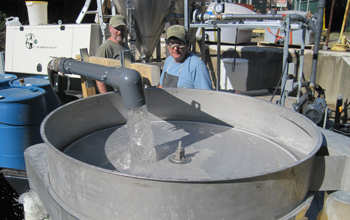Home > Press > Water and Oil Everywhere, and Now it's Safe to Drink
 |
| Clean water being passed over a vibratory separator after treatment with Osorb®. Pictured are Dr. Stephen Jolly, ABSMaterials vice president for systems, and Doug Martin, ABSMaterials production manager. Credit: Sarah Pollock, ABSMaterials |
Abstract:
Developer demonstrates oil filtration technology tested in 2010 Gulf of Mexico oil spill - NSF Webcast
Water and Oil Everywhere, and Now it's Safe to Drink
Arlington, VA | Posted on January 15th, 2011Building upon research conducted during the 2010 Deepwater Horizon oil spill in the Gulf of Mexico, engineers have incorporated a swellable nano-structured glass called Osorb® into a system for extracting pollutants like dissolved petroleum from water--and collecting the petroleum for later use.
During a webcast from the National Science Foundation, developer Paul Edmiston of the College of Wooster will demonstrate the new application for the Osorb® technology and discuss how it is being evaluated in the petroleum industry.
As part of the media briefing, Edmiston will conduct demonstrations to show how the material expands to eight times its original volume in the presence of hydrocarbons--expanding with a force that could lift 20,000 times its original weight--and filter a gasoline-tainted sample of drinking water for consumption. Questions before and during the webcast can be directed to See a video showcasing Osorb® research on The College of Wooster's YouTube channel.
Who: Osorb® developer Paul L. Edmiston of the College of Wooster and Chief Science Officer of ABSMaterials
What: Live Webcast demonstrating new oil spill remediation applications for Osorb® technology
When: Thursday, Jan. 20, 2011 at 2:00 p.m. EST
Where: Media are invited to participate in the webcast by phone or online on the Science360 website
To register for the event and obtain the user name and password for the webcast, journalists can contact NSF media officer Josh Chamot at or (703) 292-7730. Username and password are required for access. Questions before and during the webcast can be directed to
####
About National Science Foundation
The National Science Foundation (NSF) is an independent federal agency that supports fundamental research and education across all fields of science and engineering. In fiscal year (FY) 2010, its budget is about $6.9 billion. NSF funds reach all 50 states through grants to nearly 2,000 universities and institutions. Each year, NSF receives over 45,000 competitive requests for funding, and makes over 11,500 new funding awards. NSF also awards over $400 million in professional and service contracts yearly.
For more information, please click here
Contacts:
Media Contacts
Joshua A. Chamot, NSF
(703) 292-7730
John Hopkins, The College of Wooster (330) 263-2082
Program Contacts
Benaiah Schrag, NSF
(703) 292-8323
Principal Investigators
Paul Edmiston, The College of Wooster / ABSMaterials Inc.
(330) 234 7999
Copyright © National Science Foundation
If you have a comment, please Contact us.Issuers of news releases, not 7th Wave, Inc. or Nanotechnology Now, are solely responsible for the accuracy of the content.
| Related News Press |
News and information
![]() Simulating magnetization in a Heisenberg quantum spin chain April 5th, 2024
Simulating magnetization in a Heisenberg quantum spin chain April 5th, 2024
![]() NRL charters Navy’s quantum inertial navigation path to reduce drift April 5th, 2024
NRL charters Navy’s quantum inertial navigation path to reduce drift April 5th, 2024
![]() Discovery points path to flash-like memory for storing qubits: Rice find could hasten development of nonvolatile quantum memory April 5th, 2024
Discovery points path to flash-like memory for storing qubits: Rice find could hasten development of nonvolatile quantum memory April 5th, 2024
Academic/Education
![]() Rice University launches Rice Synthetic Biology Institute to improve lives January 12th, 2024
Rice University launches Rice Synthetic Biology Institute to improve lives January 12th, 2024
![]() Multi-institution, $4.6 million NSF grant to fund nanotechnology training September 9th, 2022
Multi-institution, $4.6 million NSF grant to fund nanotechnology training September 9th, 2022
Announcements
![]() NRL charters Navy’s quantum inertial navigation path to reduce drift April 5th, 2024
NRL charters Navy’s quantum inertial navigation path to reduce drift April 5th, 2024
![]() Discovery points path to flash-like memory for storing qubits: Rice find could hasten development of nonvolatile quantum memory April 5th, 2024
Discovery points path to flash-like memory for storing qubits: Rice find could hasten development of nonvolatile quantum memory April 5th, 2024
Interviews/Book Reviews/Essays/Reports/Podcasts/Journals/White papers/Posters
![]() Simulating magnetization in a Heisenberg quantum spin chain April 5th, 2024
Simulating magnetization in a Heisenberg quantum spin chain April 5th, 2024
![]() Discovery points path to flash-like memory for storing qubits: Rice find could hasten development of nonvolatile quantum memory April 5th, 2024
Discovery points path to flash-like memory for storing qubits: Rice find could hasten development of nonvolatile quantum memory April 5th, 2024
Environment
![]() Billions of nanoplastics released when microwaving baby food containers: Exposure to plastic particles kills up to 75% of cultured kidney cells July 21st, 2023
Billions of nanoplastics released when microwaving baby food containers: Exposure to plastic particles kills up to 75% of cultured kidney cells July 21st, 2023
Water
![]() Taking salt out of the water equation October 7th, 2022
Taking salt out of the water equation October 7th, 2022
Events/Classes
![]() Researchers demonstrate co-propagation of quantum and classical signals: Study shows that quantum encryption can be implemented in existing fiber networks January 20th, 2023
Researchers demonstrate co-propagation of quantum and classical signals: Study shows that quantum encryption can be implemented in existing fiber networks January 20th, 2023
|
|
||
|
|
||
| The latest news from around the world, FREE | ||
|
|
||
|
|
||
| Premium Products | ||
|
|
||
|
Only the news you want to read!
Learn More |
||
|
|
||
|
Full-service, expert consulting
Learn More |
||
|
|
||








